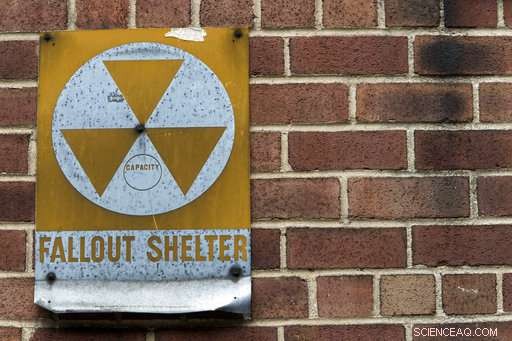
In questo martedì, 16 gennaio foto 2018, Un cartello di un rifugio antiatomico è appeso a un edificio sulla East 9th Street a New York. I rifugi antiatomici, contrassegnati da cartelli metallici con il simbolo delle radiazioni - tre triangoli uniti all'interno di un cerchio - sono stati installati in decine di migliaia di edifici a livello nazionale nei primi anni '60 durante la corsa agli armamenti nucleari. Si credeva che nella sola New York City ci fossero circa 18 persone, 000. (Foto AP/Mary Altaffer)
Una generazione di americani sapeva esattamente cosa fare in caso di attacco nucleare, o durante un grave falso allarme, come quello del fine settimana alle Hawaii. Mettiti al riparo in un edificio con il simbolo di un rifugio antiatomico giallo.
Ma in questi giorni, potrebbe non essere l'opzione migliore, o addirittura un'opzione.
Reliquie della Guerra Fredda, i vecchi rifugi che un tempo erano migliaia nelle scuole, i tribunali e le chiese non sono stati mantenuti. E la saggezza convenzionale è cambiata sul fatto che un tale sistema di rifugio sia necessario in un'epoca in cui è più probabile che un attacco provenga da uno stato canaglia debole o da un gruppo terroristico piuttosto che da una superpotenza.
"Non siamo in uno scenario da Guerra Fredda. Siamo nel 2018, " ha detto il dottor Irwin Redlener, capo del National Center for Disaster Preparedness presso l'Earth Institute della Columbia University. "Non stiamo affrontando quello che stavamo affrontando 50 anni fa, quando l'Unione Sovietica e gli Stati Uniti avevano testate nucleari puntate l'una contro l'altra che avrebbero devastato il mondo. C'è una minaccia, ma oggi è un diverso tipo di minaccia".
La gente non era sicura di cosa fare sabato quando le Hawaii hanno erroneamente inviato un avviso di allarme sul cellulare di un missile balistico in arrivo e non lo hanno ritirato per 38 minuti. Lo stato aveva istituito l'infrastruttura di allarme missilistico dopo che la Corea del Nord aveva dimostrato che i suoi missili avevano la portata per raggiungere le isole. I conducenti hanno abbandonato le auto su un'autostrada e si sono rifugiati in un tunnel. I genitori si sono rannicchiati nelle vasche da bagno con i loro figli. Gli studenti hanno attraversato il campus dell'Università delle Hawaii per mettersi al riparo negli edifici.
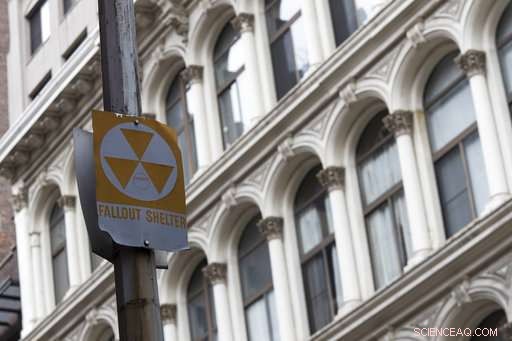
In questo martedì, 16 gennaio foto 2018, I cartelli del rifugio antiatomico sono appesi a un lampione sulla East 11th Street a New York. In un vero attacco nucleare, ripararsi in un edificio con il simbolo giallo arrugginito del rifugio antiatomico potrebbe non essere più l'opzione migliore. Gli esperti affermano che i rifugi nelle scuole e nei tribunali sono spesso resti obsoleti della Guerra Fredda che non sono stati mantenuti. (Foto AP/Mary Altaffer)
Il falso allarme è il momento perfetto per parlare di cosa fare in una tale emergenza, Redlener ha detto, perché la maggior parte delle volte la gente non ne vuole parlare. Affatto.
"Ma è una possibilità reale, " ha detto. "I funzionari della città dovrebbero parlare di cosa dovrebbero fare i loro cittadini in caso di attacco. Ed è una necessità per gli individui e le famiglie parlare e sviluppare il proprio piano di ciò che farebbero".
I newyorkesi a cui è stato chiesto questa settimana dove avrebbero cercato riparo durante un attacco missilistico hanno detto di non averne idea.
"L'unica cosa che posso pensare è, correrei, " disse Sabrina Shephard, 45, di Manhattan. "Dove correremmo, Non lo so, perché non so se New York abbia rifugi antiaerei o altro".
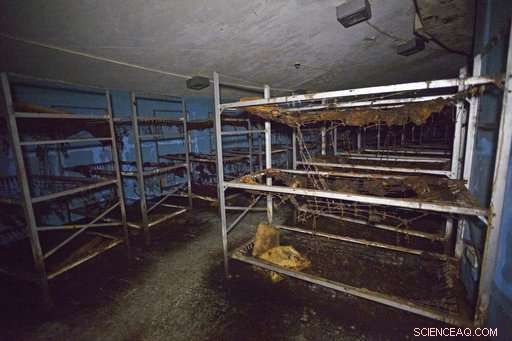
In questo martedì, 26 settembre foto 2017, una baia di letti a castello può essere vista in una stanza a forma di mezzaluna all'interno di un bunker della protezione civile dell'era della Guerra Fredda a New Orleans. Una generazione di americani sapeva esattamente cosa fare in caso di attacco nucleare - o durante un grave falso allarme, come quello del fine settimana alle Hawaii. Mettiti al riparo in un edificio con il simbolo di un rifugio antiatomico giallo. Ma in questi giorni, potrebbe non essere l'opzione migliore, o addirittura un'opzione. (Max Becherer/The Advocate via AP)
I rifugi antiatomici, contrassegnati da cartelli metallici con il simbolo delle radiazioni - tre triangoli uniti all'interno di un cerchio - sono stati installati in decine di migliaia di edifici a livello nazionale nei primi anni '60 durante la corsa agli armamenti nucleari. In New York City alone there were believed to be about 18, 000.
The locations were chosen because they could best block radioactive material. Anything could be a shelter as long as it was built with concrete, cinder blocks or brick, had no windows, and could be retrofitted quickly with supplies, an air filtration system and potable water.
But the idea was controversial from the start, especially since one of the scenarios at the time, a full-scale nuclear war between the U.S. and the Soviet Union, would have left few survivors. By the 1970s, the concept was abandoned. A FEMA spokeswoman said the agency doesn't even have current information on where the shelters are located.
New York City education officials announced last month they are taking down the fallout shelter signs at schools. In Minot, Nord Dakota, just a few miles from the base where dozens of U.S. missiles are at the ready, a few fallout shelter signs remain, but their status as viable refuges isn't known.
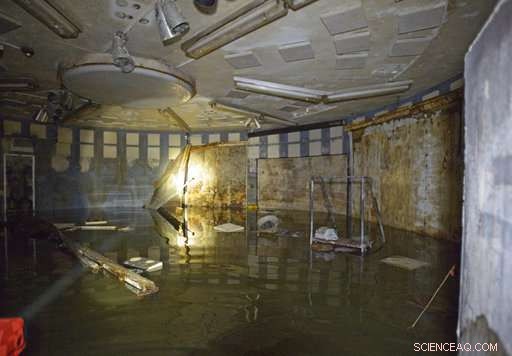
In questo martedì, 26 settembre foto 2017, a flashlight illuminates the main command center of a Cold War era Civil Defense bunker in New Orleans. The fallout shelters, marked with metal signs featuring the symbol for radiation - three joined triangles inside a circle - were set up in tens of thousands of buildings nationwide in the early 1960s amid the nuclear arms race. (Max Becherer /The Advocate via AP)
So what should you do if there is a nuclear attack now?
The good news:You may actually survive, because a nuclear attack today is more likely to be just one bomb—perhaps a small device, smuggled into a city inside a truck, or a single missile lobbed by North Korea that actually makes it across the water. The bad news:You have between 15 and 20 minutes to get to a safe space.
Eliot Calhoun, a disaster planner for New York's Emergency Management Department, said the smartest thing to do is stay put in a spot with as few windows and as many walls as possible.
"Don't go outside unless you absolutely must, " Egli ha detto.
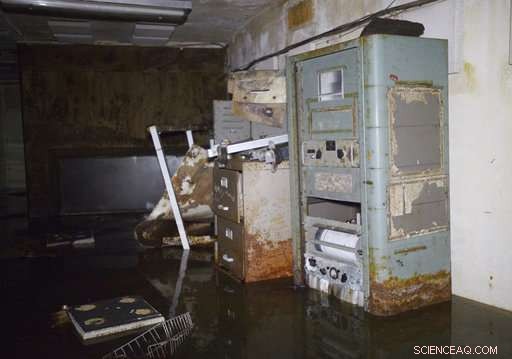
In questo martedì, 26 settembre foto 2017, old office equipment stands in a room near the entryway of a Cold War era Civil Defense bunker located in the neutral ground of West End Boulevard near Robert E. Lee Boulevard in New Orleans, La. Relics from the Cold War, the aging shelters that once numbered in the thousands in schools, courthouses and churches haven't been maintained. And conventional wisdom has changed about whether such a shelter system is necessary in an age when an attack is more likely to come from a weak rogue state or terrorist group rather than a superpower. (Max Becherer /The Advocate via AP)
Subterranean subway stations might be a good place to shelter if you happen to be in one when an attack happens, but experts say tunnels could also be dangerous if they are structurally compromised by a blast.
New Yorker Joe Carpenter emerged from a post office with a faded fallout shelter sign this week and admitted that he had never thought about what to do in the event of an incoming missile.
"I probably would just huddle with the masses and go along with the crowd, because I've never really considered it, " he said. "It's like everything else:Do we really ponder what's at the end of the road?"
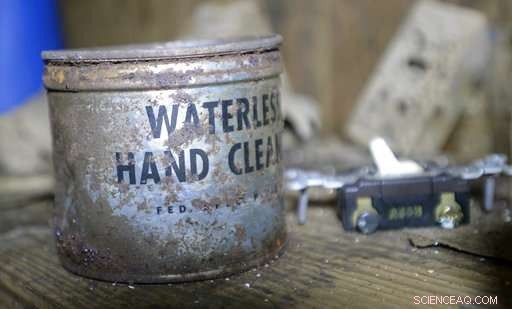
In questo martedì, 26 settembre foto 2017, a container of waterless hand cleaner sits in a storage room inside an abandoned Cold War era Civil Defense bunker in New Orleans. Relics from the Cold War, the aging shelters that once numbered in the thousands in schools, courthouses and churches haven't been maintained. And conventional wisdom has changed about whether such a shelter system is necessary in an age when an attack is more likely to come from a weak rogue state or terrorist group rather than a superpower. (Max Becherer /The Advocate via AP)
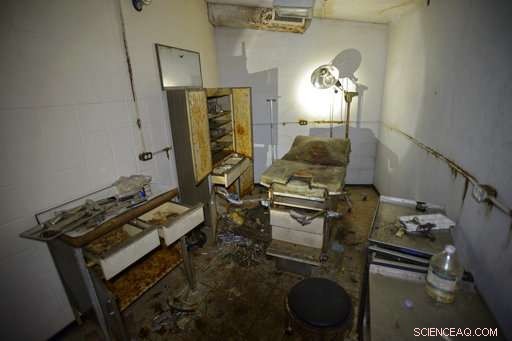
In questo martedì, 26 settembre foto 2017, an infirmary complete with a medical bed and medical instruments is seen inside a Cold War era Civil Defense bunker in New Orleans. Relics from the Cold War, the aging shelters that once numbered in the thousands in schools, courthouses and churches haven't been maintained. And conventional wisdom has changed about whether such a shelter system is necessary in an age when an attack is more likely to come from a weak rogue state or terrorist group rather than a superpower. (Max Becherer /The Advocate via AP)
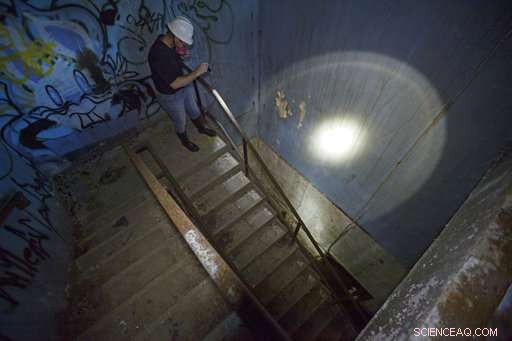
In questo martedì, 26 settembre foto 2017, Derek Boese, the Chief Administrative and Public Information Officer for the Southeast Louisiana Flood Protection Authority-East, uses a flashlight to illuminate the stair well of a Cold War era Civil Defense bunker in New Orleans. In a real nuclear disaster, taking cover in a building bearing a rusted yellow fallout shelter symbol may not be the best option anymore. Experts say the shelters in schools and courthouses are often aging relics from the Cold War that haven't been maintained. And conventional wisdom has changed. (Max Becherer /The Advocate via AP)
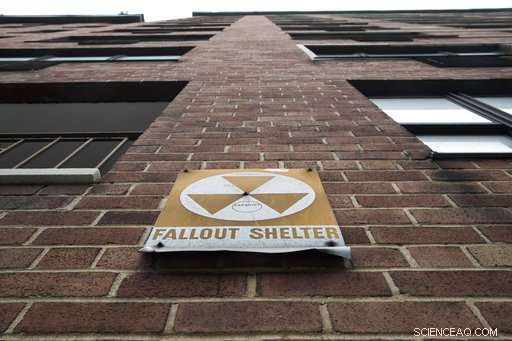
In questo martedì, 16 gennaio 2018 photo, a fallout shelter sign hangs on a building on East 9th Street in New York. A generation of Americans knew just what to do in the event of a nuclear attack—or during a major false alarm, like the one over the weekend in Hawaii. Take cover in a building bearing the yellow fallout shelter symbol. But these days, that might not be the best option, or even an option at all. (Foto AP/Mary Altaffer)
© 2018 The Associated Press. Tutti i diritti riservati.